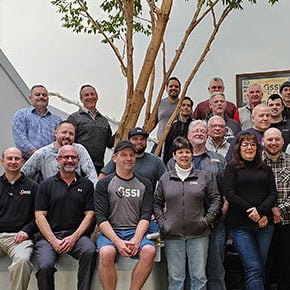Affordable, Compact and Durable New Tool for Professional Utility Location Contractors
If you take a peek inside the average professional utility contractor’s toolbox you are apt to see a variety of gear. Among all the possible methods, traditional radio detection – basically waving a wand back and forth over an area – is used most frequently. This tried and true method gives information to about 3 to 4 feet of where a target is located.
But dig deeper into the toolbox to find some newer technology that gives contractors a much higher level of horizontal accuracy, showing information to within an inch of the location. It can also differentiate among the 4 to 5 utilities that may be located in a trench, which really adds to the tool’s usefulness.
The new system is lightweight – weighing in at only 34 pounds, making it the smallest and lightest utility locating GPR system on the market. And what really seals the deal is the unit’s affordability.
Product Redesign Focused on Building an Affordable Utility Scanning Package
Creating a more affordable GPR device for the utility locating market required a complete product redesign. The goal was to develop a simple to manufacture package that would have the same performance and ruggedness as higher end utility scanning equipment.
To get to that affordable price point, the product design team focused on reducing the number of components built in-house, including expensive customized computers used for controllers. Using consumer-based electronics instantaneously reduces costs by a significant amount.
Another major plus is the wireless design, which completely eliminated any issues with controller connectors not holding up in tough field conditions. The Wi-Fi had can handle the data rates encountered, and the antenna is rugged enough to satisfy the needs of customers pushing these machines through dirt. A backup wired connection was added if Wi-Fi is not allowed on a particular site or facility, for example, at a nuclear power plant or some government offices.
Another goal was to make the unit impervious enough to water and dust so it could receive an IP 65 rating. Controller options include the consumer-based NVIDIA SHIELD tablet K1 and fully-rugged Panasonic ToughPad® FZ-B2. The more expensive ToughPad option provides the full weatherproof capability and IP65 rating. The new unit is also bomb-proof.
Portability was also on the minds of product designers. The goal was to design the system so it could fold down into the back of a small car, or even be stowed in an airplane overhead compartment. The unit measures only 22-inches by 19.25-inches by 12.5-inches. Chassis design was critically important to the overall product design process. The team explored many different options, eventually selecting a new molding technology that could make strong parts at a lower cost.
The feedback on the unit has been very gratifying for those who added the new technology to their toolboxes. Affordability was certainly the primary motivator for Peter Doyle, technical sales manager for Detection Solutions, based in Australia. Doyle has recently introduced the UtilityScan to new and existing customers – from surveyors to contract locators. “The importance of an affordable unit was immense for the customers we deal with,” said Peter. He adds, “By making it more economical, they can have more units.” He also finds the new UtilityScan to be a perfect size, offering easy setup. The wireless antenna is a great functional feature, as there are fewer plugs that can be damaged or broken.
Another happy camper is Mark Johnson, Market Manager for Ground Penetrating Radar Systems, Inc. (GPRS), the nation’s largest company specializing in detection of underground utilities and scanning of concrete structures. “The more affordable the equipment, the sooner we can put a new guy in the field and continue to grow the business,” said Johnson. He also likes the new technology’s small size “Sometimes we get into areas where we have tight spaces. Larger units on a three-wheeled cart would be more cumbersome in that type of setting and could be a disadvantage there.”
Innovative Design Features Sensor Data Fusion
So yes, it’s affordable, portable, and durable – but the internals are where the new GPR system really shines! The antenna design is based on an existing state-of-the-art digital antenna. This 350 MHz antenna uses patented HyperStacking technology that allows users to see deeper targets and operate in conditions considered too “noisy” for conventional systems. The HyperStacking design also uses less power, which allows batteries to run the system for more than eight hours. So, not as much swapping out batteries in the field.
The system design also includes LineTrac™ technology, which helps locate underground power sources like AC power and induced radio frequency (RF) energy in utilities. The new technology uses a novel approach called sensor fusion, in which coils that detect power radiated from electrical cables are fused with GPR in a single box. It produces an overlay over radar data that shows the presence of powered electrical cables.
The new technology is more affordable for the end user and provides an easier entry into the GPR market. At the same time, the system’s data fusion using multiple sensors, and easier user interface, provides an extremely high level of performance for today’s utility locators.




